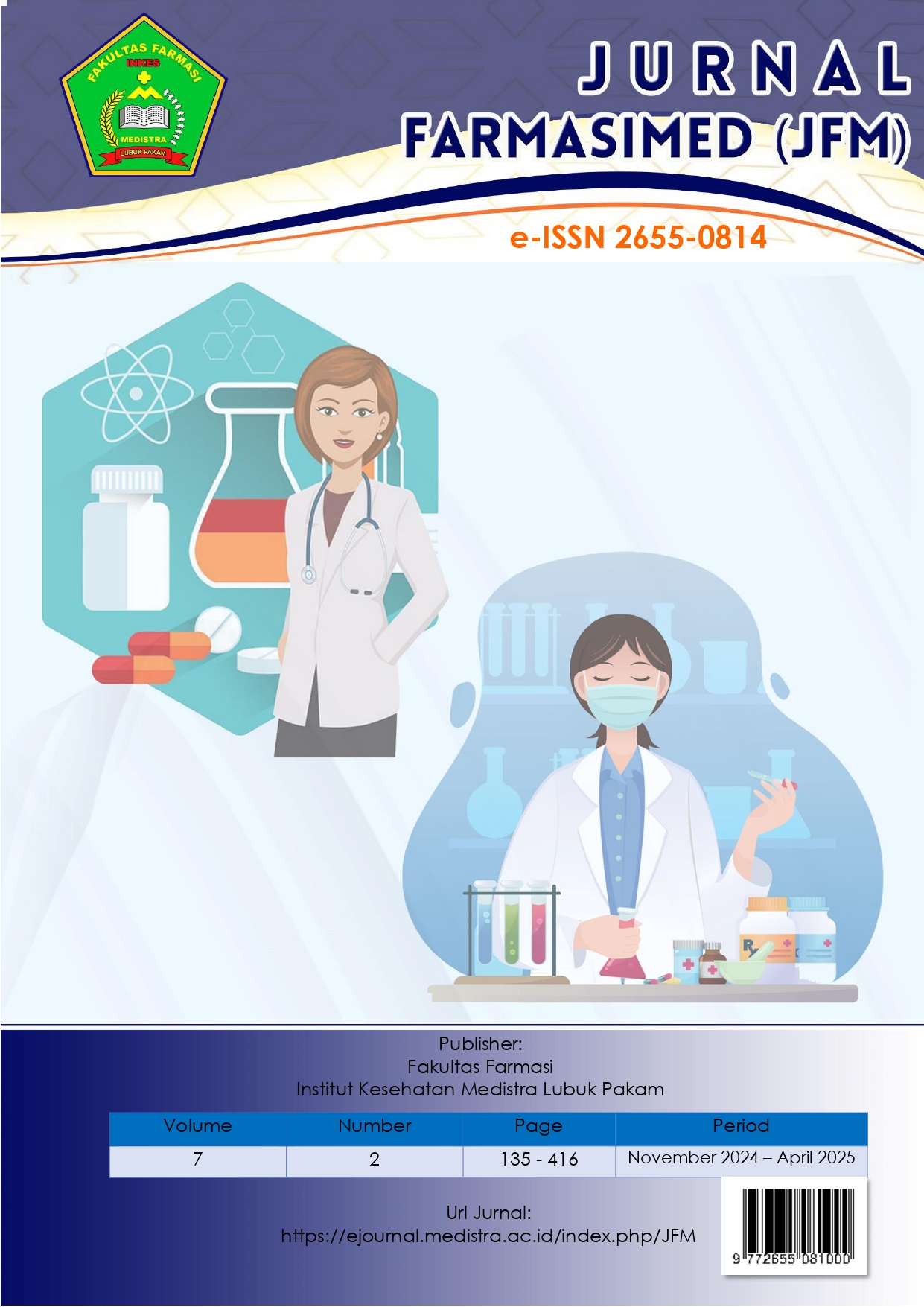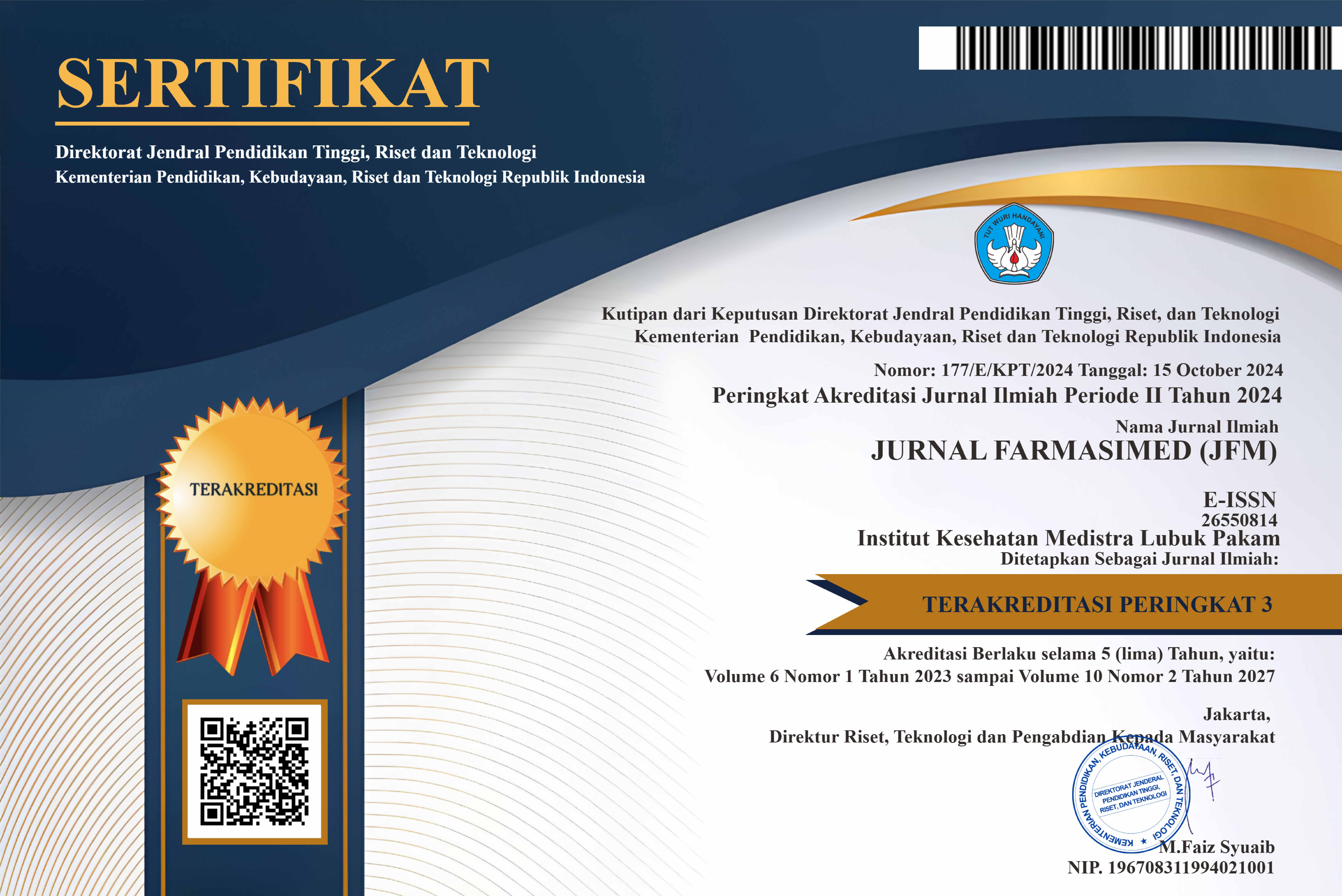Potential of Flavonoids from Cat's Whiskers Plant (Orthosiphon Stamineus) as Antidiabetic Candidates through Inhibition of Tyrosine Phosphatase 1B and Aldose Reductase Proteins
DOI:
https://doi.org/10.35451/jfm.v7i2.2654Keywords:
flavonoids, Orthosiphon stamineus, antidiabetes, PTP1B, Aldose Reductase, molecular docking, ADME, in silicoAbstract
Diabetes mellitus is a chronic metabolic disorder characterized by impaired regulation of blood glucose levels. The enzymes Protein Tyrosine Phosphatase 1B (PTP1B) and Aldose Reductase are known to play significant roles in the development of insulin resistance and diabetes-related complications. This study aims to evaluate the potential of flavonoid compounds from Orthosiphon stamineus as dual inhibitors of these enzymes through an in silico approach. The research involved phytochemical screening of flavonoids reported in O. stamineus, followed by molecular docking and validation using PyRx software on the crystal structures of PTP1B (PDB ID: 1AAX) and Aldose Reductase (PDB ID: 1AH3). Docking validation was performed via redocking of native ligands, yielding RMSD values < 2 Å. Ligand-protein interactions were analyzed using Discovery Studio, while pharmacokinetic and toxicity predictions were carried out using SwissADME, pkCSM, and ProTox-II. Docking results revealed that sinensetin and salvigenin exhibited the highest binding affinities to PTP1B and Aldose Reductase, with binding energies of -9.4 and -8.4 kcal/mol, respectively. These compounds formed strong interactions with key residues at the active sites of the enzymes, indicating their potential as effective inhibitors. Pharmacokinetic evaluation showed that most compounds complied with Lipinski’s rule of five and demonstrated favorable ADME profiles, including good absorption and potential blood-brain barrier penetration. Toxicity analysis indicated that the candidate compounds were non-toxic (toxicity class III–IV) and safe for oral administration. Flavonoid compounds from O. stamineus, particularly sinensetin and salvigenin, demonstrated strong potential as dual inhibitors of PTP1B and Aldose Reductase. This study supports further development of O. stamineus flavonoids as natural multitarget therapeutic agents for the management of diabetes mellitus.
Downloads
References
E. Kyriakis, G. A. Stravodimos, A. L. Kantsadi, D. S. M. Chatzileontiadou, V. T. Skamnaki, and D. D. Leonidas, “Natural flavonoids as antidiabetic agents. The binding of gallic and ellagic acids to glycogen phosphorylase b,” FEBS Lett, vol. 589, no. 15, pp. 1787–1794, Jul. 2015, doi: 10.1016/j.febslet.2015.05.013.
S. Lv, Z. Zhenbao, and H. and Xiao, “Flavonoids and their metal complexes as potential agents for diabetes mellitus with future perspectives,” Crit Rev Food Sci Nutr, pp. 1–31, doi: 10.1080/10408398.2025.2461238.
A. Coronell-Tovar et al., “Protein tyrosine phosphatase 1B (PTP1B) function, structure, and inhibition strategies to develop antidiabetic drugs,” Aug. 01, 2024, John Wiley and Sons Inc. doi: 10.1002/1873-3468.14901.
K. E. Fakhmi, N. Kusumaningtyas, and E. Priyatama, “Docking Molekular Potensi Anti Diabetes Melitus Tipe 2 Turunan Zerumbon Sebagai Inhibitor Aldosa Reduktase Dengan Autodock-Vina.” [Online]. Available: www.pdb.org
A. Muthoharoh, W. A. Safitri, D. B. Pambudi, and F. Rahman, “Pola Pengobatan Antidiabetik Oral pada Pasien Diabetes Mellitus Tipe 2 Rawat Jalan di RSUD Kajen Pekalongan Oral Antidiabetic Treatment in Patients Diabetes Mellitus Type 2 Outpatient in RSUD Kajen Pekalongan,” 2020. [Online]. Available: http://journals.ums.ac.id/index.php/pharmacon
I. Khoirunnisa and A. Sumiwi, “Peran Flavonoid pada Berbagai Aktivitas Farmakologi,” 2019. [Online]. Available: https://jurnal.unpad.ac.id/farmaka/rt/printerFriendly/21922/0
R. Purwandari, S. Subagiyo, and T. Wibowo, “Uji Aktivitas Antioksidan Ekstrak Daun Jambu Biji,” Walisongo Journal of Chemistry, vol. 2, Oct. 2018, doi: 10.21580/wjc.v2i2.3104.
K. Anwar and L. Triyasmono, “Kandungan Total Fenolik, Total Flavonoid, dan Aktivitas Antioksidan Ekstrak Etanol Buah Mengkudu (Morinda citrifolia L.),” Jurnal Pharmascience, vol. 3, pp. 83–92, Feb. 2016.
P. P. Putra, A. Fauzana, and H. Lucida, “In Silico Analysis of Physical-Chemical Properties, Target Potential, and Toxicology of Pure Compounds from Natural Products Analisis Sifat Fisika-Kimia, Potensi Target dan Toksikologi Senyawa Isolat Murni dari Bahan Alam dengan Metode In Silico,” 2020. [Online]. Available: http://jurnal.unpad.ac.id/ijpst/UNPAD
F. D. Oktavia Dan, “Skrining Fitokimia, Kandungan Flavonoid Total, Dan Aktivitas Antioksidan Ekstrak Etanol Tumbuhan Selaginella doederleinii,” 2021.
S. Ariani Ramadani, “Literatur Review?: Aktivitas Ekstrak Daun Jambu Biji (Psidium Guajava L) Sebagai Antioksidan Menggunakan Metode Dpph,” Makassar Natural Product Journal, vol. 2, no. 2, pp. 2024–97, 2024, [Online]. Available: https://journal.farmasi.umi.ac.id/index.php/mnpj
T. Hussain et al., “Flavonoids and type 2 diabetes: Evidence of efficacy in clinical and animal studies and delivery strategies to enhance their therapeutic efficacy,” Pharmacol Res, vol. 152, p. 104629, 2020, doi: https://doi.org/10.1016/j.phrs.2020.104629.
I. W. Sari, J. Junaidin, and D. Pratiwi, “Studi Molecular Docking Senyawa Flavonoid Herba Kumis Kucing (Orthosiphon Stamineus B.) Pada Reseptor ?-Glukosidase Sebagai Antidiabetes Tipe 2,” Jurnal Farmagazine, vol. 7, no. 2, p. 54, Aug. 2020, doi: 10.47653/farm.v7i2.194.
A. Muthoharoh, W. A. Safitri, D. B. Pambudi, and F. Rahman, “Pola Pengobatan Antidiabetik Oral pada Pasien Diabetes Mellitus Tipe 2 Rawat Jalan di RSUD Kajen Pekalongan Oral Antidiabetic Treatment in Patients Diabetes Mellitus Type 2 Outpatient in RSUD Kajen Pekalongan,” 2020. [Online]. Available: http://journals.ums.ac.id/index.php/pharmacon
P. R. Suci et al., “Aktivitas Antibakteri Formulasi Krim Ekstrak Daun Jambu Air (Syzygium Aqueum) Terhadap Bakteri Propionibacterium acnes (Antibacterial Activity of Guava Leaf (Syzygium aqueum) Leaf Extract Cream Formulation Against the Bacteria Propionibacterium acnes),” 2024.
P. Pontana Putra, A. Fauzana, and H. Lucida, “In Silico Analysis of Physical-Chemical Properties, Target Potential, and Toxicology of Pure Compounds from Natural Products,” Indonesian Journal of Pharmaceutical Science and Technology, vol. 7, pp. 107–117, Oct. 2020, doi: 10.24198/ijpst.v7i3.26403.
F. Oktavia and S. Sutoyo, “Skrining Fitokimia, Kandungan Flavonoid Total, Dan Aktivitas Antioksidan Ekstrak Etanol Tumbuhan Selaginella doederleinii,” Jurnal Kimia Riset, vol. 6, p. 141, Dec. 2021, doi: 10.20473/jkr.v6i2.30904.
I. Khoirunnisa and A. Sumiwi, “Peran Flavonoid pada Berbagai Aktivitas Farmakologi,” 2019. [Online]. Available: https://jurnal.unpad.ac.id/farmaka/rt/printerFriendly/21922/0
L. Nurdianti and I. Rahmiyani, “Uji Aktivitas Antioksidan Krim Ekstrak Daun Mangga (Mangifera indica L) Terhadap DPPH (1,1-diphenyl-2-picrylhydrazil),” Jurnal Kesehatan Bakti Tunas Husada: Jurnal Ilmu-ilmu Keperawatan, Analis Kesehatan dan Farmasi, vol. 16, no. 1, p. 50, Nov. 2016, doi: 10.36465/jkbth.v16i1.165.
I. Indra, N. Nurmalasari, and M. Kusmiati, “Fenolik Total, Kandungan Flavonoid, dan Aktivitas Antioksidan Ekstrak Etanol Daun Mareme (Glochidion arborescense Blume.),” Jurnal Sains Farmasi & Klinis, vol. 6, no. 3, pp. 206–212, Dec. 2019, doi: 10.25077/jsfk.6.3.206-212.2019.
L. R. Bollu, A. Mazumdar, M. I. Savage, and P. H. Brown, “Molecular pathways: Targeting protein tyrosine phosphatases in cancer,” Clinical Cancer Research, vol. 23, no. 9, pp. 2136–2142, May 2017, doi: 10.1158/1078-0432.CCR-16-0934.
D. R. Ningsih, D. Mantari, J. Kimia, F. Universitas, and J. Soedirman, “Ekstrak Daun Mangga (Mangifera Indica L.) Sebagai Antijamur Terhadap Jamur Candida Albicans Dan Identifikasi Golongan Senyawanya,” 2017.
K. E. Fakhmi, N. Kusumaningtyas, and E. Priyatama, “Docking Molekular Potensi Anti Diabetes Melitus Tipe 2 Turunan Zerumbon Sebagai Inhibitor Aldosa Reduktase Dengan Autodock-Vina.” [Online]. Available: Www.Pdb.Org
A. P. Prasetyo, E. Mumpuni, S. H. Rahmadhani, and S. Amin, “Studi In Silico Senyawa Bioaktif pada Daun Yakon (Smallanthus sonchifolius), Kayu Secang (Caesalpinia sappan L.), Daun Salam (Syzygium polyanthum) Sebagai Antidiabetes Mekanisme Kerja Inhibitor SGLT-2,” Pharmaceutical and Biomedical Sciences Journal (PBSJ), vol. 6, no. 2, pp. 72–85, Dec. 2024, doi: 10.15408/pbsj.v6i2.39508.
N. Jannah, R. Hairani, and E. Marliana, “Aktivitas Antioksidan Tumbuhan Genus Mangifera Dengan Metode Dpph (1,1-Diphenyl-2-Picrylhydrazyl)?: Mini Review Antioxidant Activity Of Mangifera Genus Plants Using The Dpph (1,1-Diphenyl-2-Picrylhydrazyl) Method?: A Mini Review,” vol. 9, no. 2, pp. 84–89, doi: 10.30872/ja.v9i2.1394.
T. Hussain et al., “Flavonoids and Type 2 Diabetes: Evidence of efficacy in clinical and animal studies and delivery strategies to enhance their therapeutic efficacy,” 2020.
P. Sharma, K. Sharma, and M. Nandave, “Chapter 2 - Computational approaches in drug discovery and design,” in Computational Approaches in Drug Discovery, Development and Systems Pharmacology, R. K. Gautam, M. A. Kamal, and P. Mittal, Eds., Academic Press, 2023, pp. 53–93. doi: https://doi.org/10.1016/B978-0-323-99137-7.00009-5.
S. Amin, F. Citraeni Rusdaita, and R. Prasetiawati, “Bioinformatics Study: Molecular Docking of Cat Whiskers Flavonoid Compounds for the Development of Antidiabetic Candidates,” Journal of Information System, vol. 2, no. 4, 2024, doi: 10.61487/jiste.v2i4.112.
A. Ahmad, M. Kaleem, Z. Ahmed, and H. Shafiq, “Therapeutic potential of flavonoids and their mechanism of action against microbial and viral infections—A review,” Food Research International, vol. 77, pp. 221–235, 2015, doi: https://doi.org/10.1016/j.foodres.2015.06.021.
A. A. Azam et al., “Urinary metabolomics study on the protective role of Orthosiphon stamineus in Streptozotocin induced diabetes mellitus in rats via 1H NMR spectroscopy,” BMC Complement Altern Med, vol. 17, no. 1, May 2017, doi: 10.1186/s12906-017-1777-1.
W. H. Tang, K. A. Martin, and J. Hwa, “Aldose reductase, oxidative stress, and diabetic mellitus,” Front Pharmacol, vol. 3 MAY, 2012, doi: 10.3389/fphar.2012.00087.
Downloads
Published
Issue
Section
License
Copyright (c) 2025 Adi Budi Ramadhan Adi Budi Ramadhan, Galih Hamdani Riansyah, Saeful Amin

This work is licensed under a Creative Commons Attribution-NoDerivatives 4.0 International License.
Copyright in each article is the property of the Author.

























